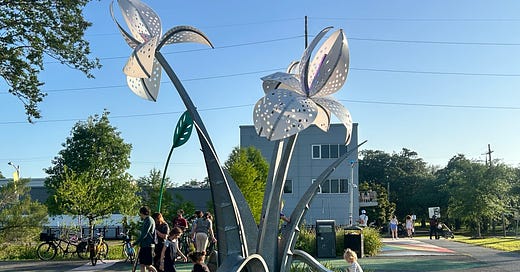The Lafitte Greenway used to be the Carondolet Canal. The present doesn't repeat the past in New Orleans, it's syncopated. Dance like nobody is watching. Make some good memories. Dance like a crab-eating macaque.
Construction on the Carondolet Canal started in 1794. It ran along the route that the Lafitte Greenway runs along now, though the greenway goes farther. The canal ran from the end of Bayou St. John to the turning basin on Basin Street. The canal was 1.6 miles long. The greenway is 2.6 miles long. It stops at the brickyard behind Winn Dixie.
The city of New Orleans purchased the canal in 1924, filling it in and using it for train tracks, which already ran next to the canal. The train ran to Basin Street Station, which is now a tourist information center. Now, where the tracks were is a collection of sports fields and exercise pavilions. There are native plantings in ditches, what the greenway people call bioswales, to help temper stormwater runoff. A trail fit for bicyclists and strollers winds through it all. There are sculptures, informative signs, and a weekly farmers market. The Lafitte Greenway connects the French Quarter with the Iberville Housing Projects, with the Lafitte Housing Projects, with Mid-City.
The parts of Mid-City the greenway runs through are the most industrial parts of the neighborhood, though some of it has been rebuilt as apartments. Then, it runs next to Winn Dixie, the supermarket, past sheet metal buildings, an architectural salvage yard, a repurposed building with a water tank on top that houses a guitar maker, a Mardi Gras float maker, artists' studios on the second floor, and a physical therapy clinic. It is across from the brickyard and the start of the train tracks. The greenway ends where the tracks begin. The train comes in the middle of the night three times a week to deliver bricks to New Orleans. It is the most economical way to transport them.
The Lafitte Greenway does not get crossed by many streets. Rather, it crosses main streets, none of them pleasant. Coming from Basin Street, the first street one crosses is Claiborne Avenue, a street made ugly in the name of historic preservation of the French Quarter, and commerce. The elevated interstate highway that runs over North Claiborne Avenue serves the third busiest port in the country. The interstate needed to go somewhere. You should see old pictures of the street. They will break your heart.
Everywhere you see a column holding up the interstate on Claiborne Avenue, there used to be a live oak tree, like the ones that line Esplanade Avenue. Claiborne Avenue was the main street for Backatown New Orleans. It still is, really, except, when there were oak trees, people used to have picnics in the Claiborne neutral ground on weekends. Now they go to City Park.
There is talk about tearing down the highway. It really is an eyesore. The thing is, the acoustics under there are irreplaceable. You should hear a brass band on Claiborne let fly. The concrete columns and the rumble of the eighteen-wheelers really brings out the brass in the notes. Zulu's headquarters is up Orleans Avenue, on the corner of Broad. Claiborne Avenue is the center of black Mardi Gras in this part of the city. It has its own traditions.
Paid subscribers don’t see this but there is a paywall right here. What follows is the benefit of providing your humble narrator with a little walking around money. He appreciates it. It is how this is possible. Consider subscribing for a month. It’s seven bucks. You won’t regret it. What’s behind the paywall is interesting in a different way.




